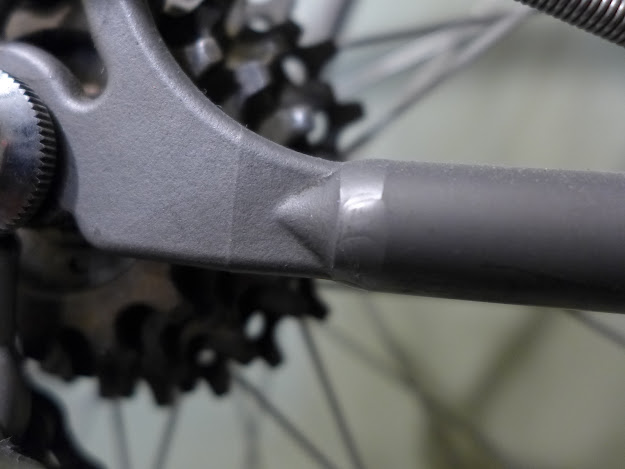I think it's always been well understood that pushing big gears is bad for one's knees. But there are a couple of trends in the bike world that are of concern.
- Some sellers of bike goodies advocate that folks ride without any form of actual attachment of the foot to the pedal
- The use of spiked pedals and grippy platform pedals for mountain biking
Here is the thing - I have this belief that even a slight reduction of peak pedaling down stroke force can have a tremendously beneficial effect on reducing knee strain and future knee problems. I've noticed that on the rare occasions when I ride with my feet "free" from any attachment to the pedal, my knees are quite achy later on (I do have some history of knee issues).
A bicycle crank tends to break due to a fatigue failure. As I understand it (I'm not a mechanical engineer), the number of cycles that a part can operate through without failure is related to peak moment on the part by a cube function. So double the peak moment at each cycle of use, and the part will fail in 1/8th the number of cycles.
Might it be that our knees respond to peak force in a similar way that our bicycle parts respond? Think about almost any activity. If you do it "easy enough" we tend to be able to do it for a very long time. But as intensity is pushed above a threshold, things really start to hurt. Even a small reduction in peak force applied to the joint might be extremely helpful in keeping below the threshold.
I suspect that many riders scoff at this concern because they may not be feeling any pain when cycling. But we start off with quite a bit of cartilage and over time it wears down. As long as there is enough, we may not feel pain. It's only when significant amounts of damage are done that we may realize that there is a problem.
As our family, friends, and ourselves age, a big determinant of our ability to engage in physical activity is the condition of our joints. Shouldn't we do everything we can to minimize the wear so that we can have more years of enjoyable cycling and other activities?
So in my world view, everyone should be clipped in or locked into their pedals as best as possible in order to pull back and up when pedaling so that the down force is reduced. Now it's important to be sure that shoes, insoles, cleats, and really the whole system is "right" so that everything is lined up properly. For many (such as myself), that means a custom orthotic is required. If you're locked/clipped in but things are not optimized, you may actually do more damage than if you rode "free". So it's really worth the effort to meet with a fit specialist and optimize things. And if the bottom of your shoes wear unevenly, I'd make a beeline to someone in your area who makes custom orthotics. Orthotics are a bargain compared with knee replacement!
Now there is one time when I do run without clips/straps/clipless pedals - that's when I'm mountain biking. The spike pedal with soft shoe combo allows a smidge more "contact" with the pedal, but lets me put a foot down more quickly than I can when otherwise attached. The ability to be unattached fast and avoid a spill is worth the wear damage to my knees. But by being attached at all other times when cycling, I keep my knees healthy enough that I can cheat a bit and go "free" once in awhile.
Recently, I've taken to using some old Cunningham WTB flip tabs. These simple widgets enable quicker foot entry with toe clips (MKS has their own version I think). I run the straps loose, but my feet go in and out of the pedals so easily that I can get some of the clip/strap benefit even when run loose, yet I can make a super quick exit.
In addition to selecting the right "equipment" to be locked into you're pedals, you can also work on your pedal stroke. If you put more effort into pulling back and pulling up when you pedal, you can reduce the wear and tear on your knees. And at the same time, you're reducing the peak moment on your bike's crank arms - so if they're vintage and you're concerned that they could fail, you're reducing the risk (or at least making it happen at a later time). How cool is that?







